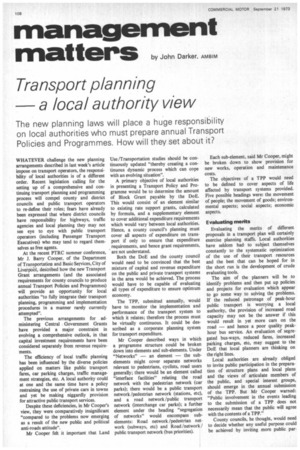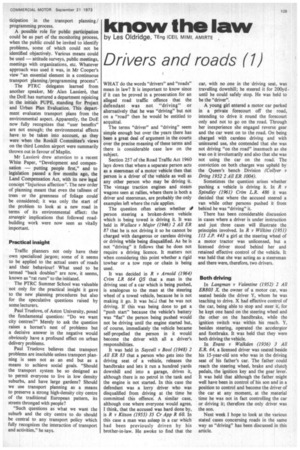management
Page 110

Page 111

If you've noticed an error in this article please click here to report it so we can fix it.
matters by John Darker, AMBIM
Transport planning a local authority view
The new planning laws will place a huge responsibility on local authorities who must prepare annual Transport Policies and Programmes. How will they set about it?
WHATEVER challenge the new planning arrangements described in last week's article impose on transport operators, the responsibility of local authorities is of a different order. Recent legislation calling for the setting up of a comprehensive and continuing transport planning and programming process will compel county and district councils and public transport operators to re-define their roles; fears have already been expressed that where district councils have responsibility for highways, traffic agencies and local planning they may not see eye to eye with public transport operators (including Passenger Transport Executives) who may tend to regard themselves as free agents.
At the recent PTRC summer conference, Mr J. Barry Cooper. of the Department of Transportatiop and Basic Services, City of described how the new Transport Grant arrangements (and the associated requirements for county councils to produce annual Transport Policies and Programmes) will provide an opportunity for local authorities "to fully integrate their transport planning, programming and implementation procedures in a manner rarely currently attempted".
The previous arrangements for administering Central Government Grants have provided a major constraint in evolving a comprehensive outlook, in that capital investment requirements have been considered separately from revenue requirements.
The efficiency of local traffic planning has been influenced by the diverse policies applied on matters like public transport fares, car parking charges, traffic management strategies, etc. A local authority could at one and the same time have a policy restraining the use of private cars in towns and yet be making niggardly provision for attractive public transport services.
Despite these deficiencies, in Mr Cooper's view, they were comparatively insignificant "compared to the problems now emerging as a result of the new public and political anti-roads attitude-.
Mr Cooper felt it important that Land Use/Transportation studies should be continuously updated "thereby creating a continuous dynamic process which can cope with an evolving situation".
A primary objective of local authorities in presenting a Transport Policy and Programme would be to determine the amount of Block Grant payable by the DoE. This would consist of an element similar to existing rate support grants, calculated by formula, and a supplementary element to cover additional expenditure requirements which would vary between local authorities. Hence, a county council's planning must cover all aspects of expenditure on transport if only to ensure that expenditure requirements, and hence grant requirements, are not understated.
Both the DoE and the county council would need to be convinced that the best mixture of capital and revenue expenditure on the public and private transport systems in the area would be achieved. The process would have to be capable of evaluating all types of expenditure to ensure optimum economy.
The TPP, submitted annually, would have to monitor the implementation and performance of the transport system to which it relates; therefore the process must be virtually continuous. It could be desscribed as a corporate planning system for transport expenditure.
Mr Cooper described ways in which a programme structure could be broken down into elements and sub-elements. Under "Networks" — an element — the subelements might cover separate networks relevant to pedestrians, cyclists, road users generally; there would be an element called "interface facilities" relating the road network with the pedestrian network (car parks); there would be a public transport network /pedestrian network (stations, etc), and a road network /public transport network (interchange car parks); a further element under the heading "segregation of networks" would encompass subelements: Road network /pedestrian network (subways, etc) and Road /network / public transport network (bus priorities). Each sub-element, said Mr Cooper, might be broken down to show provision for new works, operation and maintenance costs.
The objectives of a TPP would need to be defined to cover aspects of life affected by transport systems provided. Five possible headings were: the movement of people; the movement of goods; environmental aspects; social aspects; economic aspects.
Evaluating merits
Evaluating the merits of different proposals in a transport plan will certainly exercise planning staffs. Local authorities have seldom had to subject themselves constantly to the systematic optimization of the use of their transport resources and the best that can be hoped for in the short run is the development of crude evaluating tools.
The aim of the planners will be to identify problems and then put up policies and projects for evaluation which appear to go some way to solving the problems. If the reduced patronage of peak-hour public transport is worrying a local authority, the provision of increased road capacity may not be the answer if this would result in yet more cars on the road — and hence a poor quality peakhour bus service. An evaluation of segregated bus-ways, reduced fares, increased parking charges, etc, may suggest to the DoE that local planners are thinking on the right lines.
Local authorities are already obliged to invite public participation in the preparation of structure plans and local plans and the views of articulate members of the public, and special interest groups, should emerge in the annual submission of the TPP. But Mr Cooper warned: "Public involvement in the events leading to the submission of a TPP does not necessarily mean that the public will agree with the contents of a TPP."
County councils, he thought, would need to decide whether any useful purpose could be achieved by inviting more public par ticipation in the transport planning / programming process.
A possible role for public participation could be as part of the monitoring process, when the public could be invited to identify problems, some of which could not be identified objectively. Various means could be used — attitude surveys, public meetings, meetings with organizations, etc. Whatever approach was used it was, in Mr Cooper's view "an essential element in a continuous transport planning /programming process".
The PTRC delegates learned from another speaker, Mr Alan Lassiere, that the DoE has nurtured a department rejoicing in the initials PUPE, standing for Project and Urban Plan Evaluation. This department evaluates transport plans from the environmental aspect. Apparently, the DoE now fully recognizes that "user benefits" are not enough; the environmental effects have to be taken into account, as they were when the Roskill Committee's views on the third London airport were summarily thrown out in favour of Maplin.
Mr Lassiere drew attention to a recent White Paper, "Development and compensation — putting people first," and to legislation passed a few months ago, the Land Compensation Act, with its new legal concept -Injurious affection". The new order of planning meant that even the tallness of trees or the greenness of foliage could be considered; it was only the start of the problem to look at a new road in terms of its environmental effect: the strategic implications that followed roadbuilding work were now seen as vitally important.
Practical insight Traffic planners not only have their own specialized jargon; some of it seems to be applied to the actual users of roads and their behaviour! What used to be termed "back doubles" are now, it seems, known as "rat runs" to the initiated.
The PTRC Summer School was valuable not only for the practical insight it gave to the new planning procedures but also for the speculative questions raised by some lecturers.
Paul Truelove, of Aston University, posed the fundamental question: "Do we want city centres?" Merely to ask the question raises a hornet's nest of problems but a decisive answer in the negative would obviously have a profound effect on urban delivery problems.
Paul Truelove believes that transport problems are insoluble unless transport planning is seen not as an end but as a means to achieve social goals. "Should the transport system be so designed as to permit everyone to live in low density suburbs, and have large gardens? Should we use transport planning as a means to preserve a strong high-density city centre of the traditional European pattern, its streets thronged with people?
"Such questions as what we want the suburb and the city centre to do should be central to any transport policy which fully recognizes the interaction of transport and activities," he says.
















































































































































































